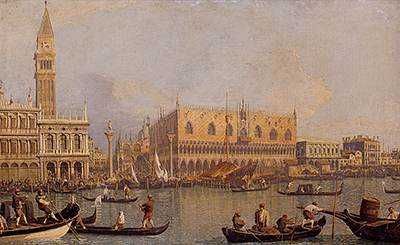Canaletto's painting of the Ducal Palace in Venice is a masterful depiction in 1732, indicating a view of the traditional Venetian ceremony. Buildings on this picture are described in the water, sky, and everything seems to be saturated with the moisture of the canals and seawater.
Canaletto equivalently presents three elements, water, land, and the atmosphere, to develop delicate, misty images that portrayed the iconic buildings. On the view of the Ducal Palace in Venice by Canaletto, a group of idle sailors surrounds a water column, and one of them whose hands are on the hips stands beside a barrel exploring the environs. Nearby are merchants and foreign visitors who perhaps recently arrived from surrounding ports; additionally, several boatmen are halting for a moment looking over the lagoons. The churches and houses' layout beyond the palace appears in steeply receding angle. Back on the street, a group of people is seen strolling, and everything unites with the golden light pouring from the sky. From the painting, it is clear that Canaletto used varying brushwork to portray different textures and materials. He used thick painting layers, impasto, combined with the transparent hues to create the white sailing on the right side while capturing the clothing forms and lights effects.
The painting delivers high resolution with high color accuracy with a great degree of detail. Canaletto focused on the atmospheric production representing the effects of light and plain air using a canvas and oil paint, which made him a forerunner of the techniques which defined the modern painting. Canaletto made meticulous views of Venice, then drew the scenes on the spot then made more detailed studies. He then transferred his opinions into a canvas, making line cuts into the prepared surface as guidelines for arches, domes, or columns. He is also known for using the Obscura camera. This dark chamber captured and reflected views using mirrors and lenses on the drawing paper to help him render the perspective lines accurately by tracing the outlines in the reflected image. The artwork is a symbolic representation of the old republic in its waver orange flag, capturing the angry mood and evocations in ancient times.
For this painting, he used various parts of the city that were popular among tourists and the old Venetians as his source of inspiration. He loved travelling through grand cities and painting vivid reproductions of the city vistas. Canaletto had remarkable attention for dramatic flourishes and intricate details, which he represented in an expressive manner, which broke with tradition to a small degree. Whilst we were still far away from the movements of the 19th and 20th century, one can see the start of an artist including their own emotions within a work rather than purely recreating every last detail found in front of them. For example, we know that Canaletto would sometimes append reality with his own imagination, such as flourishes of architecture which he felt would contribute to a better artwork, even though the particular element may not have been present in real life. One of his talents was to merge reality with touches of artistic license together in a believable manner.




